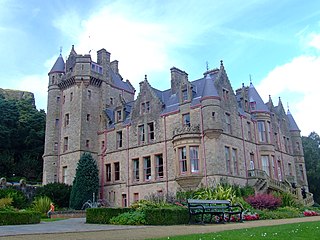Related Research Articles

Lucan is a town in Ireland, located 12 km west of Dublin city centre on the River Liffey. It is near the Strawberry Beds and Lucan Weir, and at the confluence of the River Griffeen. It is mostly under the jurisdiction of South Dublin County Council with the exception of the North Lucan areas of Laraghcon, Coldblow and Saint Catherine's Park which are in the jurisdiction of Fingal County Council. Road access to Lucan is from the N4, and the M50 motorway at Junction 7. It is widely regarded to be the Montreal of Dublin.
The architecture of Ireland is one of the most visible features in the Irish countryside – with remains from all eras since the Stone Age abounding. Ireland is famous for its ruined and intact Norman and Anglo-Irish castles, small whitewashed thatched cottages and Georgian urban buildings. What are unaccountably somewhat less famous are the still complete Palladian and Rococo country houses which can be favourably compared to anything similar in northern Europe, and the country's many Gothic and neo-Gothic cathedrals and buildings.

Anthony Ward Clare was an Irish psychiatrist and a presenter of radio and television programmes. He was the presenter of the radio series In the Psychiatrist's Chair, an interview and discussion show, which aired on BBC Radio 4.

Francis Johnston was an Irish architect, best known for building the General Post Office (GPO) on O'Connell Street, Dublin.
Scott Tallon Walker is an architecture practice with its head office in Dublin, Ireland and further offices in London, Galway and Cork. It is one of the largest architecture practices in Ireland. Established in 1931 as Scott and Good, becoming Michael Scott Architect in 1938, and Michael Scott and Partners in 1957 before changing to the current Scott Tallon Walker in 1975. Scott Tallon Walker and its earlier incarnations developed a reputation for modernism.

The Royal Victoria Eye and Ear Hospital is a public teaching hospital in Dublin, Ireland. The Royal Victoria Eye and Ear Hospital in Dublin was founded in 1895 and is the National Referral Centre for both Eye and Ear, Nose & Throat disorders.

Lanyon, Lynn & Lanyon, Civil Engineers and Architects was a 19th-century firm working mainly in Dublin and Belfast, and the leading architectural firm in Belfast during the 1860s. Its partners were Charles Lanyon, William Henry Lynn, and Charles' son John Lanyon.

St. George's Church is a former parish church in Dublin, Ireland, designed by Francis Johnston, it is considered to be one of his finest works. The structure is located at Hardwicke Place, just north of the city centre, though when it was opened this was considered to be in Drumcondra. The elegant spire, 200 feet (61.0 m) high, became a landmark of the north inner city. Along with St Andrew's Church, Chennai, it is considered one of the finest stylistic "daughter" churches to London's St Martin-in-the-Fields.

Drumcondra Hospital was a voluntary hospital on Whitworth Road in Dublin, Ireland. It became an annex to the Rotunda Hospital in 1970.

The Royal Hospital, Donnybrook is a hospital in Donnybrook, Dublin, Ireland, founded in 1743. It was originally set up as a "hospital for incurables" to provide sufferers with food, shelter and relief from their distressing conditions.

Grangegorman is an inner suburb on the northside of Dublin city, Ireland. The area is administered by Dublin City Council. It was best known for decades as the location of St Brendan's Hospital, which was the main psychiatric hospital serving the greater Dublin region. As of 2020, the area is the subject of a major redevelopment plan, running for more than a decade, under the aegis of the Grangegorman Development Agency, including the new Technological University Dublin campus.

The Whitworth Hospital was a general hospital on Morning Star Avenue in Grangegorman, Dublin, Ireland.
Professor John David Henry Widdess (1906-1982) was an Irish biologist and librarian who was recognized as Ireland's foremost medical historian. His historical publications included books on the histories of institutions such as the Royal College of Surgeons in Ireland (RCSI), the Royal College of Physicians of Ireland (RCPI), and several hospitals. In 1960, he was appointed a professor of biology in RCSI, having been a lecturer and assistant in the physiology department and librarian of the college previously. In 1973, he was awarded the Abraham Colles medal of RCSI, he became an honorary fellow of RCSI and RCPI in 1975 and 1968.

John Smyth was an Irish sculptor.

Philip Woodroffe was the resident surgeon at Dr Steevens' Hospital in Dublin for over 30 years. Several eminent surgeons were apprenticed to him. He was the president of the Royal College of Surgeons in Ireland (RCSI) in 1788.
Eoin O'Brien LRCP&SI, FRCP, FRCP, is an Irish clinical scientist. He has published extensively on hypertension as one of the major causes of death and disability in society.. Alongside his medical career, O'Brien has contributed to the field of literary criticism and biography. He has written books on writers and artists including Samuel Beckett, Nevill Johnson and Con Leventhal.

The Richmond Surgical Hospital was a general hospital in Grangegorman, Dublin, Ireland.
Frederick Darley, was an Irish architect, who designed and built a number of buildings in Dublin, including in Trinity College Dublin. He was also responsible for a number of civic and church buildings across Ireland. He was a son of the builder and architect Frederick Darley Senior, and his father served as Lord Mayor of Dublin in 1808–1809. His mother was Elizabeth (Guinness) Darley, eldest daughter of Arthur Guinness of Beaumont, Drumcondra. In 1833–1843, Darley was the Ecclesiastical Commissioners architect for the Church of Ireland Diocese of Dublin.

James Rawson Carroll was an Irish architect who was involved in many projects throughout Ireland during the Victorian Era. He was a founding partner of the Carroll & Batchelor architectural firm in 1892, alongside Frederick Batchelor.
References
- ↑ "Dictionary of Irish Architects" . Retrieved 25 October 2020.
- ↑ "Carroll, James Rawson". Dictionary of Irish Architects. Retrieved 12 September 2021.
- ↑ Goold, David. "Dictionary of Scottish Architects – DSA Architect Biography Report (December 2, 2016, 4:47 am)" . Retrieved 2 December 2016.
- ↑ "Dictionary of Irish Architects – CARROLL & BATCHELOR" . Retrieved 2 December 2016.
- ↑ "Dictionary of Irish Architects – HICKS, FREDERICK GEORGE" . Retrieved 2 December 2016.
- ↑ "Dictionary of Irish Architects – MOORE, ALBERT WALTER #" . Retrieved 2 December 2016.
- ↑ Brodie, Antonia; Library, British Architectural; Architects, Royal Institute of British (20 December 2001). Directory of British Architects, 1834–1914: Vol. 2 (L-Z). A&C Black. ISBN 9780826455147 . Retrieved 2 December 2016– via Google Books.
- ↑ "Dictionary of Irish Architects – vinycomb, john knox" . Retrieved 2 December 2016.
- ↑ "Dictionary of Irish Architects – WARD, WILLIAM HENRY" . Retrieved 2 December 2016.
- ↑ "Dictionary of Irish Architects – CO. DUBLIN, DUBLIN, BRUNSWICK STREET NORTH, HARDWICKE FEVER HOSPITAL" . Retrieved 2 December 2016.
- ↑ "Dictionary of Irish Architects – CO. DUBLIN, DUBLIN, BRUNSWICK STREET NORTH, RICHMOND SURGICAL HOSPITAL" . Retrieved 2 December 2016.
- ↑ "Dictionary of Irish Architects – CO. DUBLIN, DUBLIN, BLOOMFIELD AVENUE (DONNYBROOK), ROYAL HOSPITAL FOR INCURABLES" . Retrieved 2 December 2016.
- ↑ "Dictionary of Irish Architects – CO. DUBLIN, DUBLIN, ADELAIDE ROAD, ROYAL VICTORIA EYE & EAR HOSPITAL" . Retrieved 2 December 2016.
- ↑ "Dictionary of Irish Architects – CO. DUBLIN, DUBLIN, LINCOLN PLACE, NO. 032, ST MARK'S OPTHALMIC[sic] HOSPITAL" . Retrieved 2 December 2016.
- ↑ "Dictionary of Irish Architects – CO. DUBLIN, ST EDMUNDSBURY (LUCAN)" . Retrieved 2 December 2016.
- ↑ "Dictionary of Irish Architects – CO. DUBLIN, DUBLIN, BRUNSWICK STREET NORTH, WHITWORTH HOSPITAL" . Retrieved 2 December 2016.